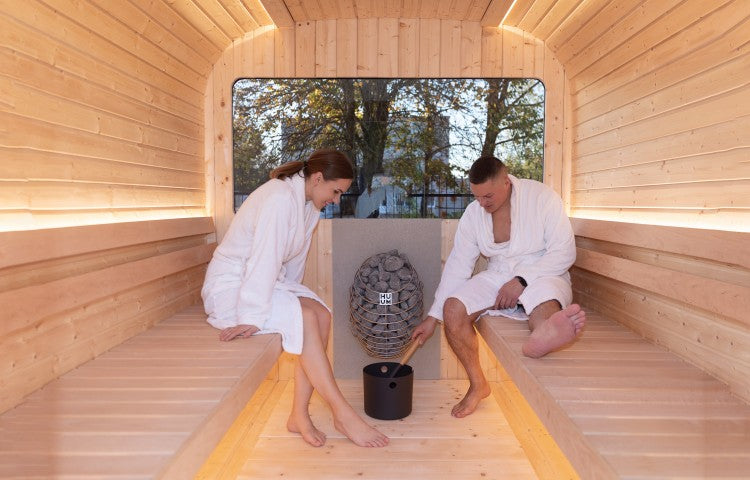Sizzle or sparkle? When it comes to Sauna/Infrared Sauna choices, it’s a sweaty showdown! Short answer: Infrared Sauna offers deeper heat and easier breathing, while traditional saunas bring the classic steam. Whether it’s a Home Sauna, Garden Sauna, or Outdoor Sauna, keep reading to discover which one truly suits your style!

Understanding the Basics: What Are Infrared and Dry Saunas?
Traditional Dry Saunas: The Classic Experience
Dry saunas have been used for centuries, offering that familiar steamy, wood-panelled room we all imagine. They heat the air using a stove and rocks, raising the temperature of the entire space.
Heating Method: Hot Rocks and Air (Convection)
These saunas use electric heaters or wood-burning stoves to heat rocks. When water is poured on the rocks, it produces steam, increasing the heat and humidity.
Typical Temperatures and Humidity
Dry saunas typically reach 70°C to 100°C with low humidity. This intense environment leads to profuse sweating, ideal for short, steamy sessions.
Infrared Saunas: Modern Heat Therapy
Infrared saunas are a newer approach, using light waves to warm the body directly instead of heating the air.
Heating Method: Infrared Light (Radiation)
Infrared panels emit light that penetrates the skin and heats your body from the inside out. There's no steam involved, making it feel much gentler.
Temperature Range and Direct Body Heating
Infrared saunas operate at 40°C to 60°C, but still promote heavy sweating. The lower ambient temperature makes them easier to tolerate for longer sessions.
Key Differences and Similarities: A Detailed Comparison
Heating Mechanisms and Temperatures
How Each Sauna Generates Heat
Dry saunas heat the air around you, creating an enveloping warmth. Infrared saunas use light to warm your body directly, allowing you to sweat at a lower temperature.
Comfort Levels and Session Duration
Infrared sessions feel milder and are often more comfortable for beginners. Traditional saunas may feel intense but offer that iconic, spa-like atmosphere.
Health Benefits: A Side-by-Side Look
Detoxification and Sweating
Both types help with sweating and flushing toxins, but infrared saunas may induce deeper sweating due to body-penetrating heat.
Cardiovascular Health and Circulation
Infrared heat can stimulate circulation and mimic mild cardio exercise. Traditional saunas also promote heart health by increasing your heart rate.
Pain Relief and Muscle Recovery
Infrared therapy is especially praised for relieving joint pain and aiding muscle recovery, making it popular for athletes.
Stress Reduction and Relaxation
Both sauna types help reduce stress. The warmth, solitude, and endorphin release contribute to a calmer mood.
Skin Health
Sweating opens pores and may help with skin clarity. Infrared heat might enhance collagen production, aiding skin rejuvenation.
Operational Aspects
Energy Efficiency and Running Costs
Infrared saunas are generally more energy-efficient. They use less electricity and heat up quicker than traditional dry saunas.
Installation and Space Requirements
Infrared saunas are often smaller and more portable, making them ideal for a home sauna setup. Dry saunas usually require more space and ventilation.
Heat-Up Time
Infrared saunas are ready in 10–15 minutes, while dry saunas can take 30–40 minutes to reach full temperature.
Choosing Your Ideal Sauna: Benefits, Considerations, and Safety

Factors to Consider Before You Buy
Personal Health Goals and Preferences
Are you looking for muscle recovery, detox, or stress relief? Infrared is great for targeted therapy. Dry saunas are better if you love that steamy, traditional feel.
Budget and Space Availability (e.g., home sauna, portable sauna)
Infrared saunas tend to be cheaper, both to buy and run. Their compact size also suits small homes and flats. Dry saunas may be better for garden sauna or outdoor sauna setups.
Overall Sauna Experience Desired
Infrared provides a gentle heat and longer sessions. Dry saunas offer a more intense, sweaty experience with ritualistic appeal.
Important Safety Guidelines and Precautions
Hydration and Session Limits
Stay well hydrated, and don’t exceed 20–30 minutes per session. Always listen to your body, especially when trying a sauna for the first time.
When to Consult a Healthcare Professional
People with heart issues, low blood pressure, or pregnant individuals should check with their GP before regular use.
Understanding EMF (Electromagnetic Field) in Infrared Saunas
Some infrared saunas emit EMFs. If you're concerned, look for low-EMF models, especially for daily use.
Takeaways
-
Infrared saunas offer gentle heat, lower energy costs, and great benefits for pain relief and detox.
-
Dry saunas provide the classic steam experience, ideal for intense sweating and relaxation.
-
Think about your health goals, budget, and space before choosing.
-
Hydrate well and stick to safe usage limits.
Conclusion
Whether you're drawn to the classic dry sauna or the sleek, modern infrared sauna, both can improve your well-being. Think of it as choosing between a warm hug and a deep tissue massage—either way, you’ll walk out relaxed, refreshed, and ready to sweat again!






